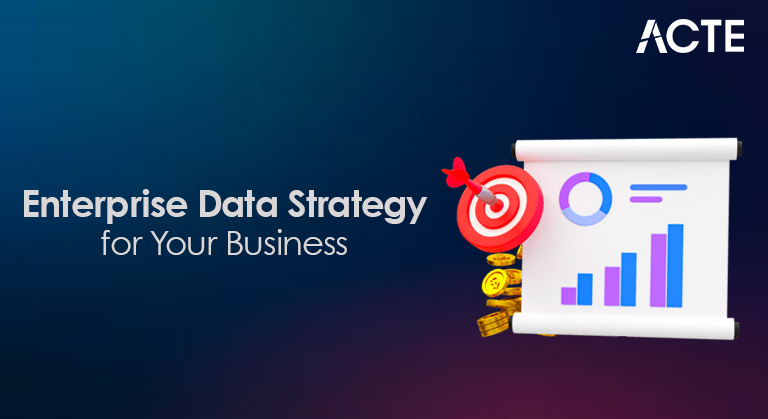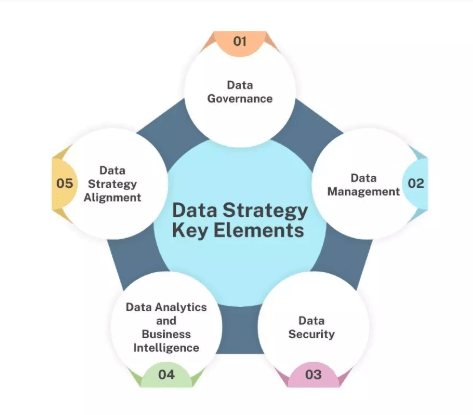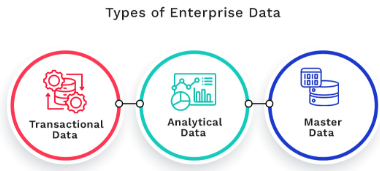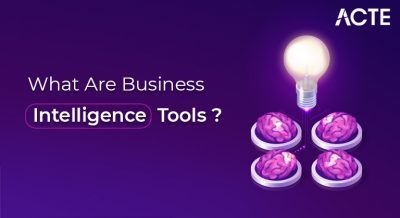
- Introduction
- Understanding the Importance of a Data Strategy
- Key Components of an Enterprise Data Strategy
- Factors to Consider When Choosing the Right Data Strategy
- Different Types of Enterprise Data Strategies
- Best Practices for Implementing an Effective Data Strategy
- Challenges to Overcome When Adopting a Data Strategy
- How to Measure the Success of Your Data Strategy
- Conclusion
Introduction to Big Data Analytics
In today’s digital age, data is one of the most valuable assets for any organization. The ability to gather, analyze, and leverage data effectively can provide a competitive edge, improve decision-making, and drive business growth. However, managing data at an enterprise level can be complex and overwhelming without a clear data strategy. An effective enterprise data strategy Business Analyst Training how an organization collects, stores, manages, and analyzes data to achieve its business goals. It ensures that the data is accurate, secure, and available to the right people at the right time. This blog will walk you through the key factors to consider when choosing the right data strategy for your business.
Understanding the Importance of a Data Strategy
A well-defined data strategy is essential for managing the growing volume and variety of data in today’s businesses. Without a strategy, organizations risk fragmented, inconsistent, and siloed data that is difficult to access and analyze. This can lead to poor decision-making and inefficiencies. Having the right data strategy in place helps ensure that: Data is aligned with business objectives and goals. Data governance and security protocols are established and followed. Data analytics and reporting are accessible to key stakeholders. The business is positioned to adapt to new data technologies and trends.
Learn the fundamentals of Business Analyst with this Business Analyst Training .
Key Components of an Enterprise Data Strategy
Before selecting a data strategy, it’s essential to understand the components that make up an enterprise data strategy. These components are critical to managing data effectively across the organization:
- Data Governance: Data governance involves the policies, processes, and standards for managing data across the organization. Tableau Comparison with BI Tools ensures that data is accurate, consistent, and used responsibly. Data governance includes defining roles and responsibilities, setting data quality standards, and ensuring compliance with regulations.
- Data Architecture: Data architecture refers to the structure of data storage, management, and processing within the organization. It defines how data is organized and accessed, ensuring that data flows efficiently across systems. The right architecture is essential for scalability, reliability, and performance.
- Data Security: Data security involves protecting sensitive data from unauthorized access and breaches. As data privacy concerns and regulations increase, ensuring that your data is secure becomes a top priority. A strong data security strategy includes encryption, access control, and regular audits.
- Data Integration: Data integration refers to the process of combining data from various sources into a single, unified view. Spotfire Explained Benefits Business allows businesses to analyze data from multiple systems, such as CRM, ERP, and external sources, to generate actionable insights. Data integration tools and technologies are crucial for creating a seamless data ecosystem.
- Data Analytics and Reporting: Data analytics is the process of analyzing data to uncover trends, patterns, and insights that can drive decision-making. A data strategy should include a clear plan for how to use analytics tools, reporting dashboards, and visualization techniques to make data accessible and actionable for business leaders.
- Business Goals and Objectives: The first step in choosing a data strategy is to align it with your organization’s business goals and objectives. Consider what the organization is trying to achieve and how data can support those goals. For example, if your goal is to improve customer experiences, your data strategy should prioritize customer data integration and analytics. If you aim to improve operational efficiency, focus on data integration and automation.
- Data Volume and Complexity: Different organizations generate different amounts and types of data. If your organization deals with large volumes of complex data, you may require a more sophisticated data strategy with advanced data processing and analytics capabilities. A large enterprise may benefit from a centralized data warehouse, whereas smaller businesses with less complex data might opt for a more decentralized approach.
- Scalability and Flexibility: Your data strategy must be scalable to Upgraded Version of Tableau . As your business expands, your data infrastructure should be able to handle increased data volumes and evolving business needs. Look for a strategy that allows you to scale easily and adapt to new technologies and data sources.
- Budget and Resources: Budget constraints and available resources are important considerations. Some data strategies may require a significant investment in technology, tools, and talent. It’s important to evaluate your current resources and ensure that you have the necessary support for implementation and ongoing maintenance.
- Regulatory Compliance: Organizations across industries are subject to regulations that govern how data is stored, processed, and shared. Ensure that your data strategy is designed to meet these compliance requirements. This may involve implementing data encryption, access controls, and audit trails to ensure data security and privacy.
- Centralized Data Strategy: In a centralized data strategy, all data is stored and managed in a central repository, such as a data warehouse. This approach allows for a unified view of all business data, making Business Analyst Training easier to manage, secure, and analyze. A centralized strategy is ideal for businesses that need a single source of truth and have the infrastructure to support it. Single point of access for data. Easier data governance and security. Simplified reporting and analytics. Can be costly and time-consuming to implement. Performance issues if data volume grows significantly.
- Decentralized Data Strategy: In a decentralized strategy, data is stored in multiple, independent systems or silos, often in different departments or business units. This approach is more flexible and can be more cost-effective for smaller organizations or those with distinct ECBA vs CCBA vs CBAP needs across departments. Flexibility to tailor data storage and management to individual business units. Lower upfront costs. Data silos can create inefficiencies and difficulties in accessing a complete view of the business. Harder to ensure data consistency and governance.
- Hybrid Data Strategy: A hybrid strategy combines elements of both centralized and decentralized approaches. It allows for centralized control of critical data while giving departments or business units more flexibility with their own data needs. Balances the control of centralized data with the flexibility of decentralized systems. Can be more scalable and adaptable as business units needs change. Can be complex to manage and integrate. Requires a solid data governance framework to ensure consistency across systems.
- Involve Key Stakeholders: Engage leadership and departmental heads to ensure that the data strategy meets the needs of all areas of the business growth.
- Invest in the Right Tools and Technology: Choose the right data management, integration, and Data analytics tools that fit your needs SAP Certification .
- Establish Strong Data Governance: Create clear policies for data quality, access, and security to maintain consistency and integrity across the organization.
- Regularly Review and Adjust: As business needs and technology evolve, ensure your data strategy is regularly reviewed and updated.
- Data Quality: Measure the accuracy, completeness, and consistency of your data. User Adoption: Track how widely the data strategy is being adopted by employees and stakeholders.
- Business Impact: Assess how the data strategy has contributed to improved decision-making, efficiency, and business performance.
- Cost Efficiency: Evaluate the return on investment (ROI) for the resources spent on implementing the data strategy.

Dive into Business Analyst by enrolling in this Business Analyst Training today.
Factors to Consider When Choosing the Right Data Strategy
Choosing the right data strategy requires careful consideration of various business factors. Below are some of the key factors that should influence your decision:
Different Types of Enterprise Data Strategies
Once you’ve assessed your organization’s needs, you’ll need to decide on the structure of your data strategy. There are several types of data strategies to choose from, each with its own advantages and challenges:

Take charge of your Business Analyst career by enrolling in ACTE’s Business Intelligence Master Program Training Course today!
Best Practices for Implementing an Effective Data Strategy
To ensure the success of your data strategy, consider the following best practices: Start with a Clear Vision: Define what you want to achieve with your data strategy and how it aligns with your business goals.
Are you getting ready for your Business Analyst interview? Check out our blog on Business Analyst Interview Questions and Answers!
Challenges to Overcome When Adopting a Data Strategy
Implementing a new data strategy can come with several challenges. Data Silos Different departments may have different approaches to data, making it hard to integrate and create a unified view. Data Quality Issues Inconsistent or poor-quality data can undermine the effectiveness of your data strategy. Resistance to Change Employees may resist adopting new processes or tools. Complete List of SAP Modules essential to foster a culture of data-driven decision-making to overcome this challenge. Technological Limitations Legacy systems or incompatible technologies can hinder the success of your data strategy. Additionally, ensuring proper data governance is crucial to maintain security, compliance, and accountability. Limited skills or lack of data literacy within the organization can slow down implementation. Finally, aligning the data strategy with business objectives is vital to drive meaningful outcomes.
How to Measure the Success of Your Data Strategy
Once implemented, it’s essential to measure the success of your data strategy. Key performance indicators (KPIs) may include:
Conclusion
Choosing the right enterprise data strategy is crucial for unlocking the full potential of your data. By Business Analyst Training key factors like business growth, data volume, scalability, and compliance, you can make an informed decision that aligns with your organization’s needs. Whether you opt for a centralized, decentralized, or hybrid approach, a well-executed data strategy will enable you to manage data effectively, enhance decision-making, and drive business growth. By adopting the right data strategy, you can ensure that your organization stays ahead in a data-driven world.





